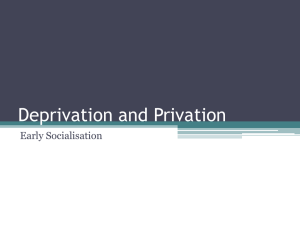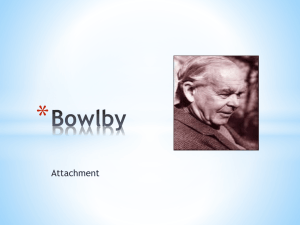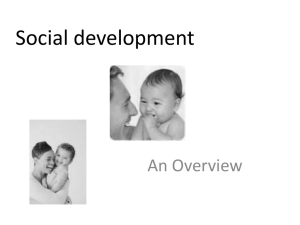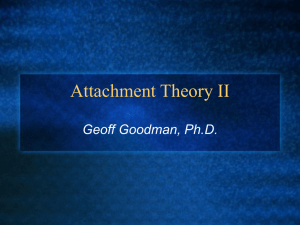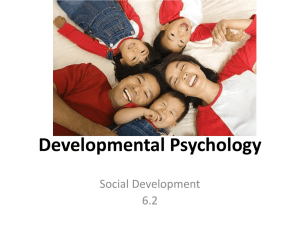P3 Attachment Theory
advertisement
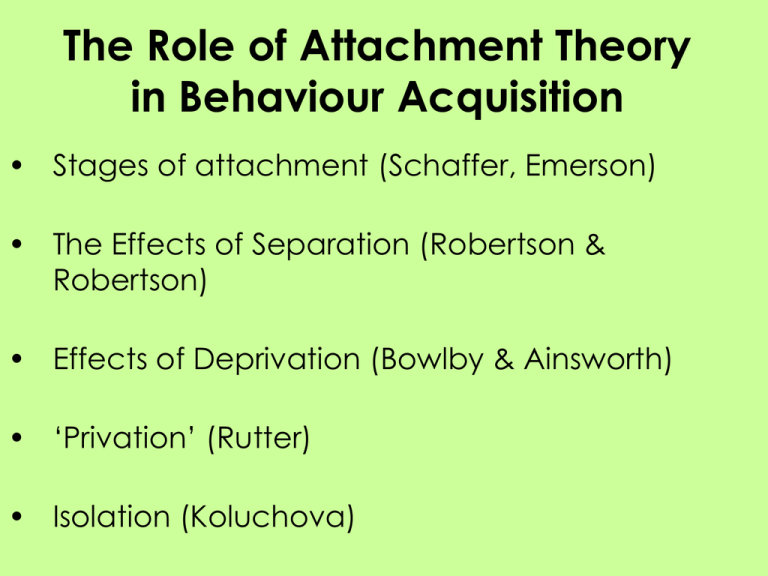
The Role of Attachment Theory in Behaviour Acquisition • Stages of attachment (Schaffer, Emerson) • The Effects of Separation (Robertson & Robertson) • Effects of Deprivation (Bowlby & Ainsworth) • ‘Privation’ (Rutter) • Isolation (Koluchova) Schaffer & Emerson The Development of Attachments The Asocial Stage: Birth to 6 weeks At this age babies don’t care who you are! They respond to humans in the same way they respond to inanimate objects. Primary care givers sometimes get a bit fed up at the lack of response to them! There is no attachment at the moment. Schaffer & Emerson The Development of Attachments Indiscriminate Attachment: 6 weeks to 7 months Infants can distinguish between people and objects and are becoming more sociable with people But, they have not yet formed attachments are happy to be held by anyone, even Paris!! Schaffer & Emerson The Development of Attachments Specific Attachment: from 7 months The infant show signs of having formed a strong emotional bond with a particular person (usually, but not always, the mother). Separation Anxiety – they cry and protest when separated from their attachment figure Stranger Anxiety – they show distress when left with strangers and are unhappy until they are reunited with their attachment figure. Robertson & Robertson The Effects of Separation James and Joyce Robertson carried out observations on children in the 1950s who were admitted to hospital. Parents were not allowed to spend much time with their children in hospital in the 1950s. Their own daughter was distraught when admitted to hospital and separated from them, and they realised that separation at this young age could have damaging effects. Robertson identified 3 stages of emotional distress - PDD PROTEST – the children showed great distress, calling and crying for the absent care giver and some appeared panic stricken. Anger & fear were evident Robertson identified 3 stages of emotional distress - PDD DESPAIR – the children became calmer but apathetic as they showed little interest in anything. Self comforting behaviours were observed such as thumb sucking and rocking. Robertson identified 3 stages of emotional distress - PDD DETACHMENT – the children appeared to be coping with the separation as they showed more interest in their surroundings but thy were emotionally unresponsive. They avoided forming new attachments and showed no interest when the care giver returned. Most children reestablished the relationship over time. Bowlby – The Effects of Deprivation & Maternal Deprivation Hypothesis • If a child is deprived of its mother between 6 months and 5 years then this would lead to difficulties later in life. • They would be unable to form attachments with others and would be more like to turn to crime. • Separation experienced in early childhood caused affectionless psychopathy. Do you think maternal deprivation hypothesis could explain their behaviour? Did they form an attachment to each other? Bowlby: 44 Thieves Study • He interviewed 88 children, 44 had been reported for thieving and 44 had emotional problems but had not committed any crimes. • He found that the thieves lacked a social conscience. • 32% of thieves were diagnosed as affectionless psychopaths and 86% of this group had experienced separation for at least a week before the age of 5. • Bowlby concluded that maternal deprivation can seriously disrupt healthy emotional development. • What do you think? The Artful Dodger! Rutter - Privation • Privation occurs when a child forms no bond at all with a care giver. When might this happen? (Baby P?) • Children in orphanages where there is low staff-tochild ratio have been found to suffer from privation because they have no interaction with others. Rutter - Privation • Rutter found that if separation was associated with illness it was not associated with delinquency, but if separation was associated with stress, children were four times as likely to become delinquent. Baby P Do you think he was neglected? Would he have suffered from privation? Were there others in his life to form attachments? • He said that Bowlby’s thieves had probably suffered from PRIVATION not deprivation. • Privation involves a situation where no bond is formed in the first place. This much more serious than deprivation where a bond is disrupted but can, with care, be re-formed. Koluchova - Isolation • In 1972 Koluchova reported the case of two identical twins who ad been beaten, locked and cruelly treated until the age of 7. They only communicated using gestures and were terrified of the outside world. • The were rescued and fostered by a devoted foster mother and they both developed language and social and cognitive skills. By 20 they were both in employment and had good relationships with their foster mother. • Does this study show (as Koluchova says) that the effects of early privation can be overcome if the care provided is of sufficient quality? Harlow – Rhesus Monkey Experiments Harlow forced baby monkeys to be separated from their mother, provided them with two wire dolls, one with just milk attached and one that was comfy and nice. Surprise surprise, the monkey spent most of it’s time with the comfy ‘mum’ and only fed off the wire ‘mum’. Harlow concluded that feeding a child does not necessarily form a bond. The baby monkeys reared this way could not form bonds with their own offspring in later life. • Questions: Does maternal deprivation hypothesis explain delinquent behaviour? Is it a criminal’s fault that they commit crime if they never formed an attachment in early life? • Is there any hope for an affectionless psychopath? • Is attachment theory nature or nurture? • What hope is there for a child who has experienced privation?
